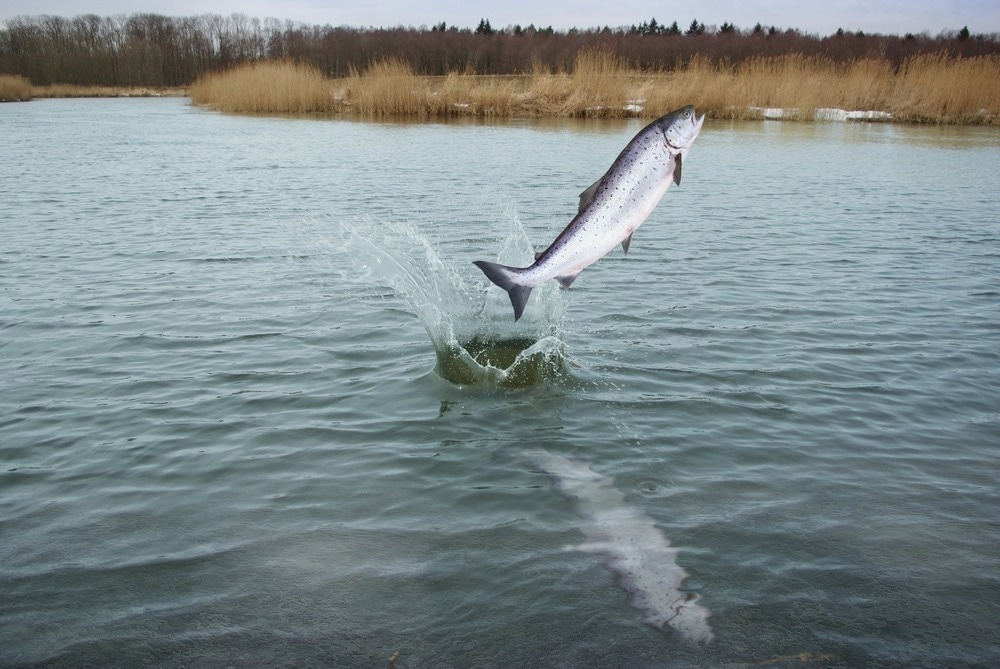Recent research has examined how mining in northwestern North America impacts the ecosystems that support salmonids, or ray-finned fish species such as salmon, trout, and chars. The researchers say that a more ecological approach to mine planning can make mining less damaging to these important animals’ natural habitats.

Image Credit: Krasowit/Shutterstock.com
The groundbreaking study, published in the open access interdisciplinary science journal Science Advances in 2022, is authored by an interdisciplinary team of biologists, environmental scientists, environmental protection agency workers, and activists from universities, government departments, and nonprofit organizations in the United States and Canada.
The authors estimate that the region their study focuses on, northwestern North America, has had almost 4000 productive mines in it in the past. Contemporary operations in the region vary, from small placer sites to open pit facilities mining over 118 million tons of material annually.
Impact assessments are generally produced as part of mine planning and risk mitigation, but mines still damage watersheds (areas of land that drain water into a specific body, such as a river or lake) that salmonids rely on through toxic contamination, burying stream channels, and altering the flow regime.
The researchers outlined critical timeframes during the life cycle of governance for a mine operation where operators could reduce the risks their mine will pose to salmonid populations. They recommend that stakeholders plan for the complexity of multiple stressors on an ecosystem, the cumulative effects of multiple stressors happening simultaneously, and considerations of how the environment will change in the future.
Mining Puts Aquatic Ecosystems in Danger
Mining can endanger aquatic ecosystems such as salmonid watersheds in several ways. It can alter water and sediment chemistry, impact the local water cycle, and harm organisms’ health, from tiny microbes to large mammals, including humans. The impacts of mining cover large geographic areas and remain in place for long periods of time.
In one example, in Spain’s Rio Tinto region, copper mining pollution is still having an impact over 5,000 years since mining began. Pollution can spread hundreds of kilometers downstream from mines. The mine waste now covers around one million square kilometers worldwide.
The present study’s authors chose to focus on salmonids in northwestern North America because they are an important species ecologically and culturally protected by legislation, they have a large home range, and the region they live in is important for mining.
The researchers argued that if mining policies can be changed to protect salmonid populations in this area, then they can likely be changed to protect other parts of watershed ecosystems.
What Risks Does Mining Pose to Salmonids?
Salmonid species move at long ranges through essential ecosystems, including the large boreal and coastal rainforests of British Columbia and Alaska, long stretches of rivers such as the Yukon and Fraser, and ecologically essential river valleys.
Because of this movement throughout the watershed, the researchers said that mining in this region poses multiple and complex risks to these species. These risks are outlined below.
The natural flow of groundwater and surface waters is altered by mining activities such as open pit dewatering, waste dumping in streams and wetlands, and blocking or changing stream channels to make room for mine infrastructure. Mines and their infrastructure can permanently bury stream channels and wetlands, eliminating salmonids’ physical habitats.
As well as modifying these natural patterns, mining can cool or warm surface waters in river valleys when water and tailings impoundment facilities release water. Groundwater is crucial for salmonid species to grow and survive, as many incubate their eggs in these environments.
Metal and coal mining also affects the geochemical stability of disturbed material, which often pollutes waters downstream of the mine. Metal contamination has been detected hundreds of kilometers downstream of the pollution source, and these particles threaten the health of the entire watershed that salmonids rely on for survival.
The risks a mine can pose to salmonids in northwestern North American watersheds are not wrapped up when the mine stops operating. Pollution can continue to threaten the ecosystem long after a mine has closed, especially if there is acid-generating rock or if the mine used tailings impoundment facilities.
How to Protect Salmonids from the Risks of Mining
The researchers concluded that the risks of mining to salmonids and the watersheds that support them had previously been underestimated. They argued for an ecological approach that considers the complexity of stressors on the watershed, cumulative effects from multiple stressors happening simultaneously, and future considerations, including the impacts of global climate change.
The study states that mining companies have numerous opportunities to better protect northeastern North American salmonid-bearing watersheds. These are in various aspects of mining governance: regional planning, impact assessments, research and monitoring, and data collection.
Applying the ecological – and cautious – approach to risk identification and mitigation modeled in this paper would help protect salmonids from mining risks.
References and Further Reading
Olías, M., and J.M. Nieto (2015). Background Conditions and Mining Pollution throughout History in the Río Tinto (SW Spain). Environments. doi.org/10.3390/environments2030295
Sergeant, C.J., et al (2022). Risks of mining to salmonid-bearing watersheds. Science Advances. doi.org/10.1126/sciadv.abn0929
Simonin, M. et al (2021). Consistent declines in aquatic biodiversity across diverse domains of life in rivers impacted by surface coal mining. Ecological Applications. doi.org/10.1002/eap.2389
Disclaimer: The views expressed here are those of the author expressed in their private capacity and do not necessarily represent the views of AZoM.com Limited T/A AZoNetwork the owner and operator of this website. This disclaimer forms part of the Terms and conditions of use of this website.